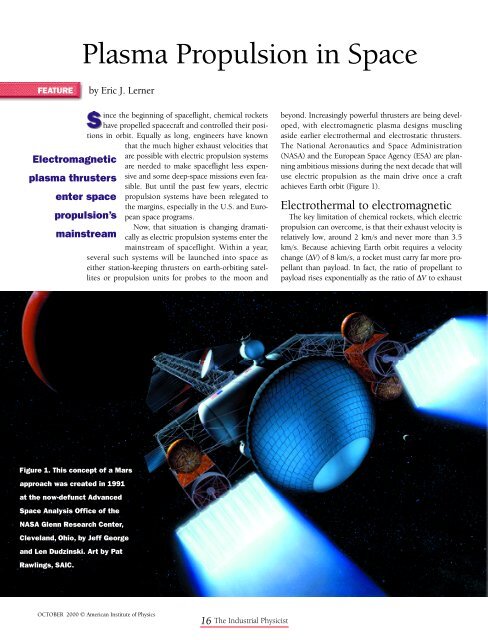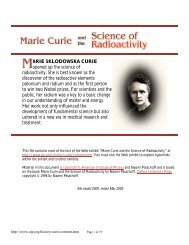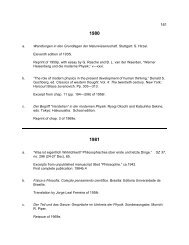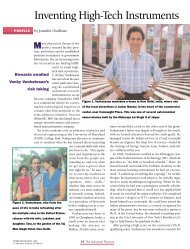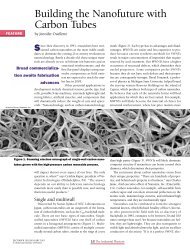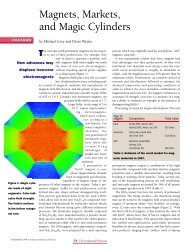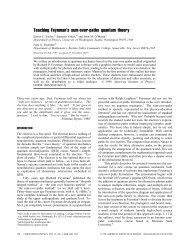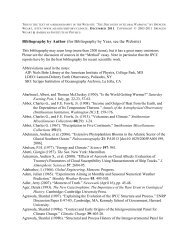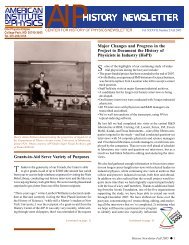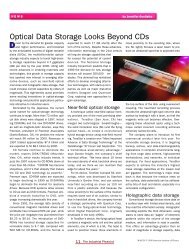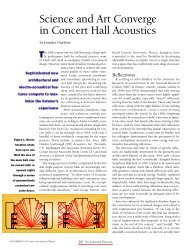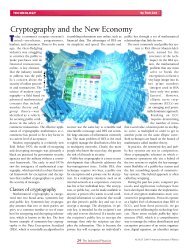Plasma Propulsion in Space - American Institute of Physics
Plasma Propulsion in Space - American Institute of Physics
Plasma Propulsion in Space - American Institute of Physics
You also want an ePaper? Increase the reach of your titles
YUMPU automatically turns print PDFs into web optimized ePapers that Google loves.
FEATURE<br />
Electromagnetic<br />
plasma thrusters<br />
<strong>Plasma</strong> <strong>Propulsion</strong> <strong>in</strong> <strong>Space</strong><br />
by Eric J. Lerner<br />
<strong>in</strong>ce the beg<strong>in</strong>n<strong>in</strong>g <strong>of</strong> spaceflight, chemical rockets<br />
have propelled spacecraft and controlled their positions<br />
<strong>in</strong> orbit. Equally as long, eng<strong>in</strong>eers have known<br />
that the much higher exhaust velocities that<br />
are possible with electric propulsion systems<br />
are needed to make spaceflight less ex p e nsive<br />
and some deep-space missions even feasible.<br />
But until the past few years, electric<br />
propulsion systems have been relegated to<br />
the marg<strong>in</strong>s, especially <strong>in</strong> the U.S. and European<br />
space programs.<br />
N o w, that situation is chang<strong>in</strong>g dramatically<br />
as electric propulsion systems enter the<br />
ma<strong>in</strong>stream <strong>of</strong> spaceflight. With<strong>in</strong> a year,<br />
several such systems will be launched <strong>in</strong>to space as<br />
either station-keep<strong>in</strong>g thrusters on earth-orbit<strong>in</strong>g satellites<br />
or propulsion units for probes to the moon and<br />
enter space<br />
propulsion’s<br />
ma<strong>in</strong>stream<br />
Figure 1. This concept <strong>of</strong> a Mars<br />
approach was created <strong>in</strong> 1991<br />
at the now-defunct Advanced<br />
<strong>Space</strong> Analysis Office <strong>of</strong> the<br />
NASA Glenn Research Center,<br />
Cleveland, Ohio, by Jeff George<br />
and Len Dudz<strong>in</strong>ski. Art by Pat<br />
Rawl<strong>in</strong>gs, SAIC.<br />
OCTOBER 2000 © <strong>American</strong> <strong>Institute</strong> <strong>of</strong> <strong>Physics</strong><br />
16 The Industrial Physicist<br />
beyond. Increas<strong>in</strong>gly powerful thrusters are be<strong>in</strong>g developed,<br />
with electromagnetic plasma designs muscl<strong>in</strong>g<br />
aside earlier electrothermal and electrostatic thrusters.<br />
The National Aeronautics and <strong>Space</strong> Ad m i n i s t r a t i o n<br />
(NASA) and the European <strong>Space</strong> Agency (ESA) are plann<strong>in</strong>g<br />
ambitious missions dur<strong>in</strong>g the next decade that will<br />
use electric propulsion as the ma<strong>in</strong> drive once a craft<br />
achieves Earth orbit (Figure 1).<br />
Electrothermal to electromagnetic<br />
The key limitation <strong>of</strong> chemical rockets, which electric<br />
propulsion can overcome, is that their exhaust velocity is<br />
relatively low, around 2 km/s and never more than 3.5<br />
km/s. Because achiev<strong>in</strong>g Earth orbit requires a velocity<br />
change (ΔV) <strong>of</strong> 8 km/s, a rocket must carry far more propellant<br />
than payload. In fact, the ratio <strong>of</strong> propellant to<br />
payload rises exponentially as the ratio <strong>of</strong> ΔV to exhaust
Neutral gas<br />
velocity <strong>in</strong>creases, and so orbit<strong>in</strong>g payloads are typically<br />
only 1% <strong>of</strong> total lift-<strong>of</strong>f mass. (<strong>Propulsion</strong> eng<strong>in</strong>eers <strong>of</strong>ten<br />
refer to specific impulse, which is proportional to<br />
exhaust velocity. A specific impulse <strong>of</strong> 100 s is equivalent<br />
to an exhaust velocity <strong>of</strong> 1 km/s.)<br />
Even for low-velocity operations, such as ke e p i n g<br />
communication satellites from drift<strong>in</strong>g <strong>of</strong>f station, the<br />
lower the exhaust velocity, the larger the mass <strong>of</strong> propellant<br />
needed. So a large fraction <strong>of</strong> a satellite’s mass delivered<br />
to orbit must be propellant for station-keep<strong>in</strong>g.<br />
Electric propulsion can alleviate these problems by<br />
provid<strong>in</strong>g far higher exhaust velocities and, thus, greatly<br />
reduc<strong>in</strong>g the required propellant mass. But early electricpropulsion<br />
devices had their own limitations.<br />
The first electric propulsion thrusters were electrothermal,<br />
<strong>in</strong> which the propellant was heated by contact<br />
with a heated coil or by pass<strong>in</strong>g an arc through ionized<br />
propellant. Resistojets, which use resistance-heated<br />
coils, started to enter widespread commercial use <strong>in</strong> the<br />
early 1980s, provid<strong>in</strong>g the small thrusts needed to keep<br />
satellites on station.<br />
Resistojets could not susta<strong>in</strong> temperatures above<br />
3,000 K, however, so exhaust velocities could not exceed<br />
10 km/s, even with the lightest propellant, hydrogen.<br />
By the early 1990s, resistojets were superseded by arc<br />
jets, <strong>in</strong> which direct currents <strong>of</strong> tens or hundreds <strong>of</strong><br />
amperes passed though the propellant, heat<strong>in</strong>g it to tens<br />
<strong>of</strong> thousands <strong>of</strong> kelv<strong>in</strong>s at the axis. The natural tendency<br />
<strong>of</strong> currents <strong>in</strong> plasma to p<strong>in</strong>ch together through <strong>in</strong>teraction<br />
with their own magnetic fields keeps these higher<br />
temperatures away from the walls <strong>of</strong> the device and<br />
allows exhaust velocities <strong>of</strong> more than 10 km/s. But the<br />
electrodes are still exposed to very high temperatures, so<br />
the power <strong>of</strong> the devices must rema<strong>in</strong> low or their lifetime<br />
becomes short.<br />
To achieve both high exhaust velocities and longer lifetimes,<br />
designers and manufacturers <strong>in</strong> the mid-1990s<br />
started to emphasize electrostatic propulsion, also known<br />
as ion propulsion. In electrostatic units, a downstream<br />
grid accelerates ions from a source. After the ions are<br />
accelerated, a stream <strong>of</strong> electrons is <strong>in</strong>jected to neutralize<br />
the exhaust and prevent a buildup <strong>of</strong> charge on the<br />
spacecraft that would counteract the accelerat<strong>in</strong>g field.<br />
This design—which entered station-keep<strong>in</strong>g duty <strong>in</strong><br />
1994 and was first used on a NASA space probe <strong>in</strong> 1998<br />
(see The Industrial Physicist, June 1998, pp. 24–26)—provides<br />
exhaust velocities <strong>of</strong> 100 km/s. In addition, beam<br />
divergence is small (20°), efficiency high (65%), and life-<br />
Anode<br />
Anode<br />
Figure 2. Schematic <strong>of</strong> a Hall thruster with an extended <strong>in</strong>sulator<br />
channel, show<strong>in</strong>g the external cathode, <strong>in</strong>ternal anode, radial<br />
magnetic field, and typical particle trajectories.<br />
time long (20,000 h). Because the beam <strong>of</strong> ions is positively<br />
charged dur<strong>in</strong>g acceleration and builds up a charge<br />
that combats the accelerat<strong>in</strong>g force, there are serious limits<br />
to how much thrust can be developed per unit area <strong>of</strong><br />
nozzle—a few newtons per square meter at best.<br />
Hall-effect thrusters<br />
The way around space-charge limitation is through<br />
electromagnetic thrusters, also called plasma thrusters,<br />
which accelerate a neutral plasma by the <strong>in</strong>teraction <strong>of</strong><br />
magnetic fields and currents. By far, the most developed<br />
members <strong>of</strong> this propulsion family are the Hall-effect<br />
thrusters, which were <strong>in</strong>vented <strong>in</strong> the United States <strong>in</strong><br />
the 1960s but then abandoned by the West. The Soviet<br />
space program perfected them, however, and beg<strong>in</strong>n<strong>in</strong>g<br />
<strong>in</strong> 1972, the Soviets orbited about 100 <strong>of</strong> the thrusters<br />
for satellite control and propulsion. Only <strong>in</strong> the past year<br />
or so have Hall thrusters been re-adopted by the European<br />
and U.S. space communities.<br />
In a Hall thruster, magnetic coils generate a radial field<br />
perpendicular to an electric field along the axis (Figure<br />
2). The Hall effect traps the electrons <strong>in</strong> the plasma, forc<strong>in</strong>g<br />
them to move <strong>in</strong> a circle around the axis. [When a<br />
conductor carries an electric current (current density Jx)<br />
perpendicular to a magnetic field (field strength Bz), a<br />
voltage gradient (Ey) develops perpendicular to both the<br />
current and the magnetic field.] But the much heavier<br />
ions, which are almost unaffected by the magnetic field,<br />
are accelerated down the axis by the electric field. The<br />
electrons gradually drift <strong>in</strong> the opposite direction to<br />
complete the circuit, but—slowed by the magnetic<br />
17 The Industrial Physicist<br />
Magnetic<br />
coils<br />
Insulator<br />
channel<br />
Axis <strong>of</strong> symmetry<br />
Magnetic field<br />
Electric field<br />
+ _ _ +<br />
Cathode<br />
Ions<br />
Electrons
field—they do not move fast enough to short out the<br />
field. In other words, the magnetic field diverts the electrons<br />
just enough to produce the right amount <strong>of</strong> resistance<br />
to keep the current from short<strong>in</strong>g.<br />
Because the plasma rema<strong>in</strong>s neutral, much higher<br />
thrust densities (thrust per unit area) can be achieved<br />
than with electrostatic ion propulsion, a big advantage<br />
for both station-keep<strong>in</strong>g and deep-space missions. The<br />
first Western mission likely to use Hall thrusters beyond<br />
Earth orbit will be the SMART-1 probe, which ESA plans<br />
to send <strong>in</strong>to lunar orbit <strong>in</strong> late 2001. After launch <strong>in</strong>to<br />
Earth orbit by a chemically powered Ariane-5 booster,<br />
SMART-1 will spend six months cruis<strong>in</strong>g to the moon for<br />
a six-month lunar-orbit<strong>in</strong>g mission. The French firm<br />
SNECMA developed the t<strong>in</strong>y 10-cm-diameter thruster <strong>in</strong><br />
collaboration with the Russian space program. It provides<br />
a much smaller thrust than a chemical rocke t —<br />
lead<strong>in</strong>g to a much longer transit time to the moon—but<br />
uses far less propellant, allow<strong>in</strong>g a larger payload. As <strong>in</strong><br />
many electric propulsion devices, xenon is the propellant<br />
for SMART-1.<br />
Although no Hall thrusters have yet flown on NASA<br />
missions, two companies are actively pursu<strong>in</strong>g their<br />
development. Primex Aerospace Co. (Redmond, WA) is<br />
develop<strong>in</strong>g devices closely modeled on the Soviet and<br />
Russian varieties, termed stationary plasma thrusters<br />
( S P Ts). These use an <strong>in</strong>sulat<strong>in</strong>g channel to stretch out<br />
the region <strong>in</strong> which ions are accelerated. So far, the prototypes<br />
that have been built and tested have generated<br />
up to 0.4 N <strong>of</strong> thrust with 6 kW <strong>of</strong> <strong>in</strong>put power.<br />
“Right now, we are work<strong>in</strong>g to optimize the thrust by<br />
chang<strong>in</strong>g the exact shape <strong>of</strong> the magnetic field and<br />
<strong>in</strong>creas<strong>in</strong>g the lifetime <strong>of</strong> the thrusters,” expla<strong>in</strong>s Roger<br />
M. Myers, director <strong>of</strong> systems and technology development<br />
at Primex. In addition, researchers are try<strong>in</strong>g to<br />
reduce the large, 45° plume divergence <strong>of</strong> the Hall<br />
thrusters. Such large plumes can pose problems <strong>in</strong> locat<strong>in</strong>g<br />
thrusters on some spacecraft.<br />
P r i m ex’s competition is International <strong>Space</strong> Te c h n o l o-<br />
18 The Industrial Physicist<br />
THE LITTLE ENGINE THAT COULD<br />
An ion-propulsion eng<strong>in</strong>e driv<strong>in</strong>g Deep <strong>Space</strong> 1 has operated for<br />
more than 4,800 h s<strong>in</strong>ce its launch on Oct. 24, 1998, surpass<strong>in</strong>g<br />
the previous record for an eng<strong>in</strong>e operat<strong>in</strong>g <strong>in</strong> space by some<br />
1,000 h. The craft, a NASA test-bed for advanced technology, is the<br />
first space vehicle to use an ion eng<strong>in</strong>e as its primary propulsion<br />
system. The highly efficient eng<strong>in</strong>e uses only about 100 g <strong>of</strong> xenon<br />
a day as propellant. Deep <strong>Space</strong> 1 completed its primary mission <strong>of</strong><br />
assess<strong>in</strong>g the ion eng<strong>in</strong>e and 11 other systems <strong>in</strong> September<br />
1999, about two months after a flyby that took it with<strong>in</strong> 26 km <strong>of</strong><br />
the asteroid 9969 Braille. The craft, now more than 333 million<br />
kilometers from Earth, is <strong>in</strong> the midst <strong>of</strong> an eight-month burn<br />
<strong>in</strong>tended to propel it toward a rendezvous with Comet Borrelly <strong>in</strong><br />
September 2001. NASA extended the mission to target Borrelly <strong>in</strong><br />
the hope that the craft will make new comet discoveries. If Deep<br />
<strong>Space</strong> 1 completes its full mission shortly thereafter, its ion-propul-<br />
sion eng<strong>in</strong>e will have logged more than 14,000 h <strong>of</strong> operation.<br />
g y, Inc. (ISTI), a jo<strong>in</strong>t venture <strong>of</strong> Loral Corp. (Palo Alto,<br />
CA) and the Russian designer and manufacturer <strong>of</strong> all Hall<br />
thrusters flown to date. ISTI has requalified to We s t e r n<br />
standards the Russian SPT-100, a device that delivers 93<br />
mN <strong>of</strong> thrust at an <strong>in</strong>put power <strong>of</strong> 1,350 W and a specific<br />
impulse <strong>of</strong> 1,500 s. It will be flown on commercial spacecraft<br />
built by Loral and two French prime contractors<br />
start<strong>in</strong>g next year. A higher- p o w e r, higher-efficiency unit is<br />
be<strong>in</strong>g developed with co-fund<strong>in</strong>g from the U.S. Air Force.<br />
MPD for high thrust<br />
For deep-space missions, those beyond the <strong>in</strong>fluence<br />
<strong>of</strong> Earth’s gravity, higher thrust is required, and more<br />
powerful types <strong>of</strong> electric propulsion may be needed.<br />
One <strong>of</strong> the most promis<strong>in</strong>g systems uses the fully electromagnetic<br />
magnetoplasmadynamic (MPD) thruster, <strong>in</strong><br />
which the accelerat<strong>in</strong>g force is applied directly to the<br />
neutral plasma. In an MPD thruster, a cont<strong>in</strong>uous arc<br />
flows radially outward from a central cathode to a coaxial<br />
anode. The <strong>in</strong>teraction <strong>of</strong> the radial current with the<br />
azimuthal, circular magnetic field that it produces generates<br />
a Lorentz force that accelerates the plasma down the<br />
barrel <strong>of</strong> the electrodes and focuses it beh<strong>in</strong>d the end <strong>of</strong><br />
the cathode (Figure 3).<br />
Exhaust velocities <strong>of</strong> 40 km/s or more are obta<strong>in</strong>ed <strong>in</strong><br />
this manner. More important, MPD thrusters have a very<br />
high thrust density, <strong>in</strong> theory as much as 100,000 N/m 2 .<br />
La b o r a t o ry models <strong>of</strong> the thruster have yet to perform<br />
this well, but they have nonetheless achieved impressive<br />
results. At NASA’s Jet <strong>Propulsion</strong> La b o r a t o ry (JPL), a 200kW<br />
MPD device only 11 cm <strong>in</strong> radius generated 12.5 N,<br />
or 400 N/m 2 , more than 10 times the thrust density<br />
achieved by Hall thrusters.<br />
With high power flow<strong>in</strong>g though a small area, one <strong>of</strong><br />
the key challenges that MPD must overcome is cathode<br />
erosion at high temperatures. “The best way we’ve found<br />
to reduce cathode erosion is to use lithium as the propellant,<br />
flow<strong>in</strong>g it out through the cathode,” ex p l a i n s<br />
Edgar Choueiri, director <strong>of</strong> the Electric <strong>Propulsion</strong> and
<strong>Plasma</strong> Dynamics La b o r a t o ry at Pr<strong>in</strong>ceton<br />
U n i v e r s i t y, which is develop<strong>in</strong>g MPD<br />
thrusters for JPL. Liquid lithium at 1,000 °C<br />
flows <strong>in</strong>to the cathode, where heat generated<br />
by the current vaporizes it. The lithium Propellant<br />
<strong>in</strong>lets<br />
vapor then exits through holes <strong>in</strong> the cathode,<br />
is ionized, and becomes the propellant.<br />
This design has allowed MPD thrusters to<br />
function without appreciable erosion for<br />
500 h, which would be enough time for a<br />
200-kW thruster to accelerate a 1-ton<br />
spacecraft to 22 km/s. MPD thrusters convert<br />
only about 15% <strong>of</strong> their <strong>in</strong>put energy<br />
<strong>in</strong>to waste heat, which must be radiated<br />
away from the spacecraft. This is a big<br />
advantage <strong>in</strong> space, where radiators can add<br />
significant mass to spacecraft.<br />
MPD thrusters have not yet been used <strong>in</strong> any spacecraft,<br />
but they are under study for several ambitious missions.<br />
One serious stick<strong>in</strong>g po<strong>in</strong>t is that any thruster that<br />
consumes more than about 100 kW <strong>of</strong> power will almost<br />
certa<strong>in</strong>ly need a nuclear-power source because this<br />
demand is too much for solar panels to supply. With<br />
present technology, that source would be a fission reactor,<br />
and major safety concerns must be met before large<br />
fission reactors could be launched <strong>in</strong>to space.<br />
What next?<br />
NASA is fund<strong>in</strong>g the <strong>in</strong>vestigation <strong>of</strong> even higher-performance<br />
and more technologically challeng<strong>in</strong>g plasmapropulsion<br />
systems. One such concept is the variable<br />
specific impulse magnetic rocket (VASIMR), which is<br />
under development at NASA’s Advanced <strong>Space</strong> <strong>Propulsion</strong><br />
Laboratory (Houston, TX). Although VASIMR is not<br />
a fusion reactor, it derives from a controlled-fusion concept,<br />
the magnetic mirror. Magnetic-mirror mach<strong>in</strong>es<br />
conta<strong>in</strong> plasma by plugg<strong>in</strong>g the ends <strong>of</strong> a cyl<strong>in</strong>drical<br />
chamber with strong magnetic fields.<br />
In VA S I M R, one <strong>of</strong> the ends is made deliberately<br />
leaky, so that plasma streams out at 70 km/s, generat<strong>in</strong>g<br />
thrust. By strengthen<strong>in</strong>g or weaken<strong>in</strong>g the magnets at<br />
the aft end, the leakage can consist <strong>of</strong> more mass at<br />
lower velocities and, thus, more thrust, or less mass at<br />
higher velocities, to produce less thrust. This design<br />
would allow the eng<strong>in</strong>e to generate high thrust when it is<br />
needed to escape a planet’s gravitational field, and low<br />
thrust to conserve propellant on <strong>in</strong>terplanetary cruises.<br />
Energy is supplied to the plasma by radio- f r e q u e n c y<br />
p o w e r, which would be supplied by a fission reactor.<br />
Although VASIMIR has been under development for 20<br />
years, efforts have accelerated s<strong>in</strong>ce 1997. Serious tech-<br />
Insulator<br />
Electric <strong>Propulsion</strong> and <strong>Plasma</strong> Dynamics<br />
Lab., Pr<strong>in</strong>ceton University<br />
Cathode<br />
Anode<br />
Figure 3. Schematic <strong>of</strong> a magnetoplasmadynamic thruster. The <strong>in</strong>teraction<br />
<strong>of</strong> the current density vector, J, with the self-<strong>in</strong>duced magnetic field, B,<br />
produces a body force density, J × B, that accelerates the plasma to high<br />
exhaust velocities, produc<strong>in</strong>g thrust.<br />
nical problems rema<strong>in</strong>, such as how to efficiently detach<br />
the plasma from the magnetic field that conta<strong>in</strong>s it.<br />
The only real alternative to fission reactors as an energy<br />
source for high-performance plasma propulsion is<br />
fusion, and NASA has several projects <strong>in</strong>vestigat<strong>in</strong>g the<br />
possibility <strong>of</strong> fusion-based space propulsion. One idea is<br />
a device called the plasma focus, which is similar to an<br />
MPD thruster, except that the electrodes are reversed,<br />
with the cathode be<strong>in</strong>g the outside electrode. A plasma<br />
focus operates <strong>in</strong> a pulsed mode, us<strong>in</strong>g a burst <strong>of</strong> electricity<br />
from a capacitor bank that generates a sheet <strong>of</strong><br />
current that runs down the barrel <strong>of</strong> the coaxial electrodes.<br />
The current p<strong>in</strong>ches together at the end <strong>of</strong> the<br />
electrode, produc<strong>in</strong>g highly compressed knots <strong>of</strong> plasma,<br />
or plasmoids, less than 1 mm across. These plasmoids<br />
are heated to high temperature by their <strong>in</strong>ternal<br />
currents, generat<strong>in</strong>g fusion reactions. Their decay generates<br />
a highly focused ion beam that shoots away from<br />
the device at velocities <strong>of</strong> up to 10,000 km/s. In theory,<br />
such ion beams could be used for ultrahigh specificimpulse<br />
propulsion, powered by the fusion energy generated<br />
by the focus itself. However, experimental work<br />
on this idea rema<strong>in</strong>s on a small scale.<br />
Whether such advanced concepts will ever fly is an<br />
open question. But it is certa<strong>in</strong> that plasma propulsion<br />
will play an <strong>in</strong>creas<strong>in</strong>gly central role <strong>in</strong> space propulsion<br />
for both Earth-orbit and deep-space missions.<br />
For further read<strong>in</strong>g<br />
Fo<strong>in</strong>g, B. H; Raca, G. R. Adv. <strong>Space</strong> Res. 1999, 23,<br />
1865.<br />
Chang Diaz, F. R. Fusion Tech. 1999, 35, 87.<br />
Marcucci, M. G.; Polk, J. E. Rev. Sci. Instrum. 2000,<br />
71, 1389.<br />
19 The Industrial Physicist<br />
J<br />
J B<br />
B<br />
<strong>Plasma</strong><br />
exhaust


